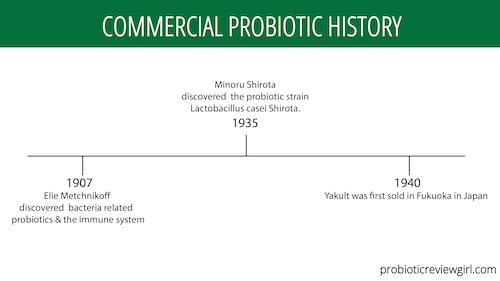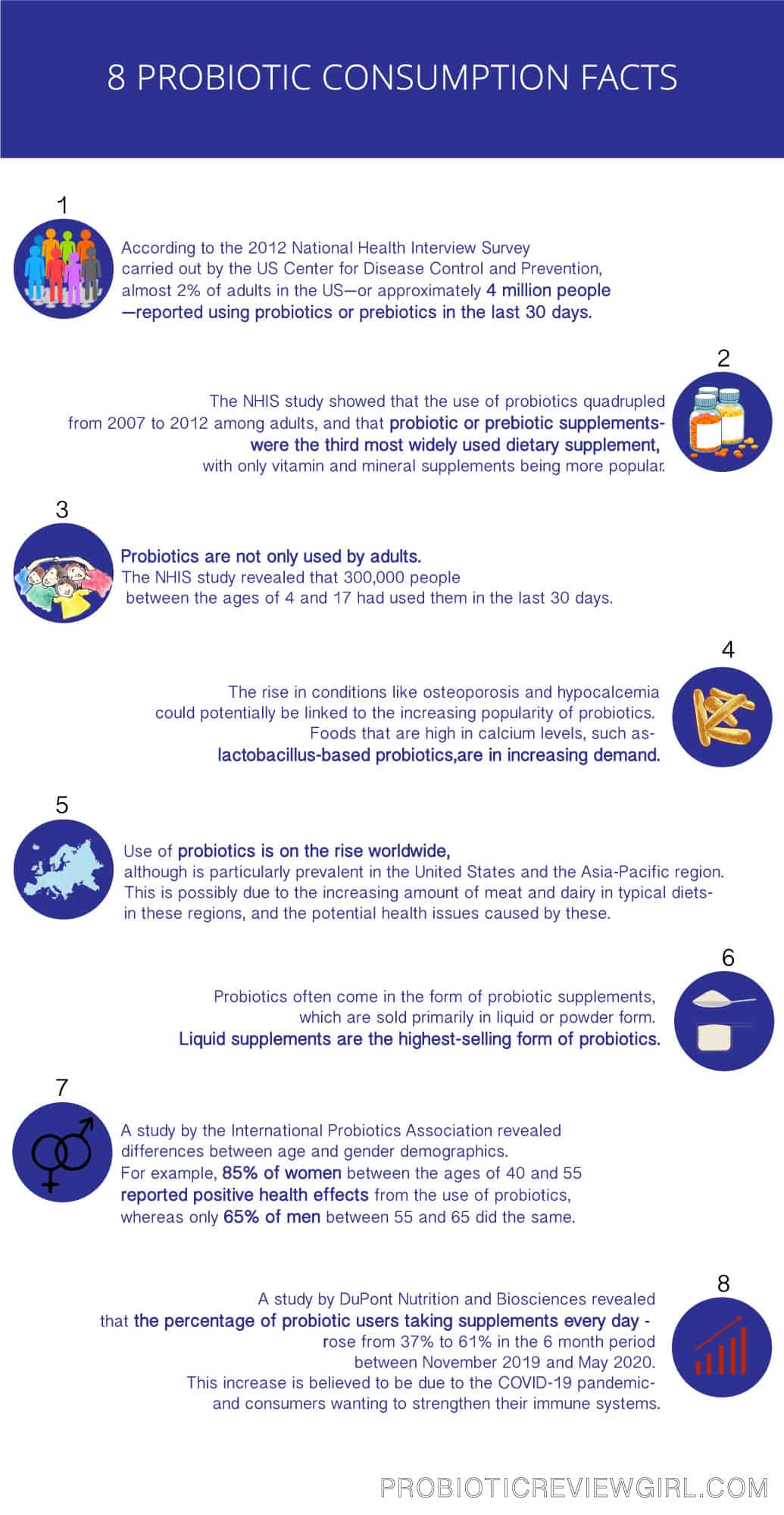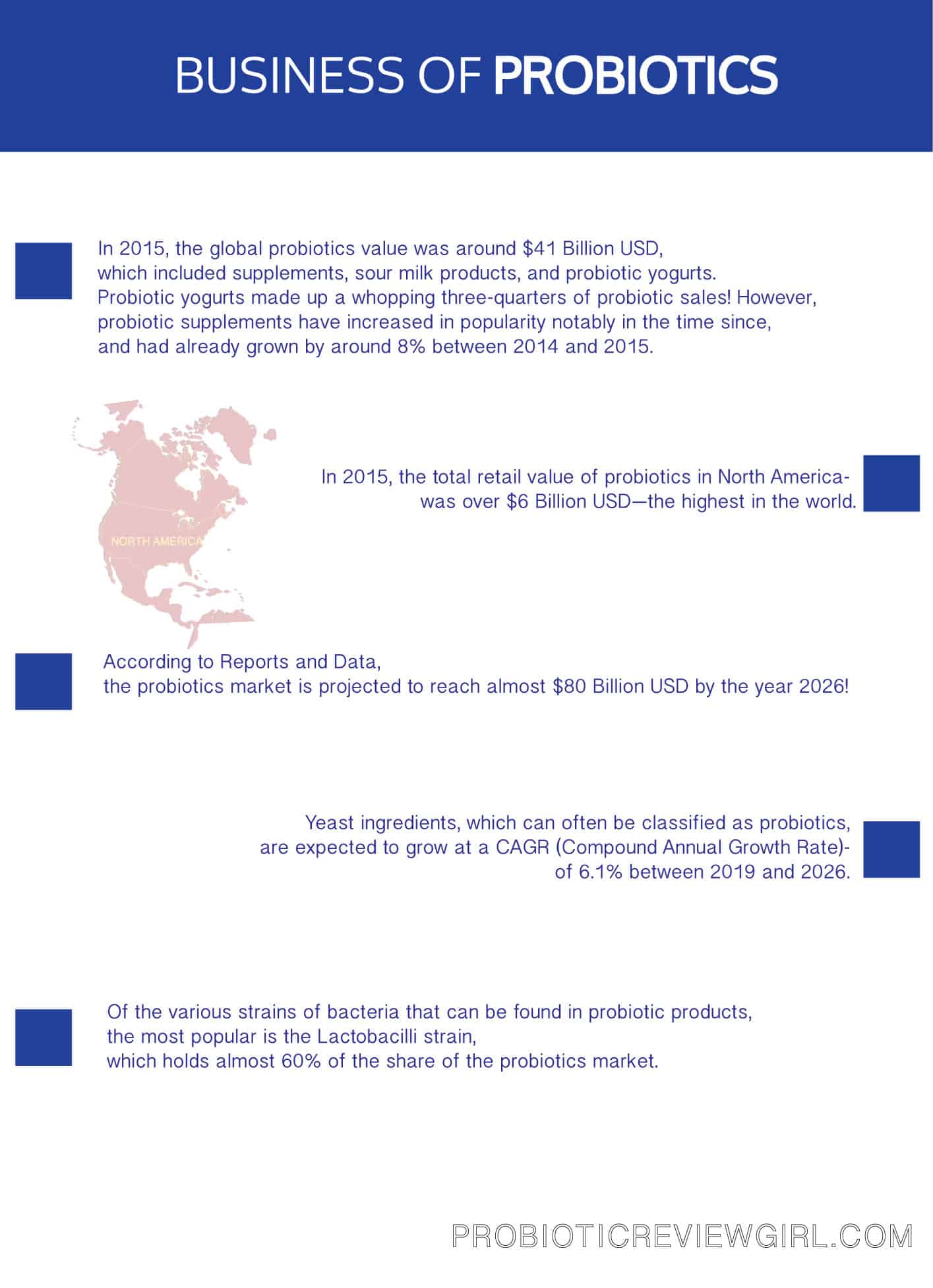Probiotics are undoubtedly extremely popular, and are becoming more so every day. But how big exactly is the probiotics market? How many people use probiotics? When did probiotics start being used?
We have carried out research to put together this list of fascinating statistics and facts about probiotics to answer the most common questions about one of the most popular trends in health and wellbeing.
Probiotic History
Probiotics are living microorganisms (usually bacteria strains or yeasts) that are believed to have positive effects on digestive health and the immune system.
Although probiotic strains of bacteria have existed and been consumed since the dawn of time, it wasn’t until the 20th Century that they began to be discovered by scientists.
There were a few major breakthroughs that led to where we are now.
- While some bacteria were believed to have health benefits before this, the direct link between (we now know as) probiotics and the immune system was discovered in 1907 by Nobel-Prize-winning scientist Elie Metchnikoff of Paris’ Pasteur Institute. Metchnikoff discovered that people living in Bulgaria’s Caucasus Mountains were frequently exceeding the age of 100, and established a link between this and the daily consumption of a fermented yogurt drink.
- Metchnikoff discovered that the drink contained a strain of bacteria which later became known as Lactobacillus bulgaricus. Metchnikoff continued to research probiotics, and his research enabled other scientists to discover more probiotic strains.
- The word “probiotic” became used to describe these bacteria. In Latin, the word translates roughly to “for life”.
- The first commercially-sold probiotic is believed to be the yogurt drink Yakult, which you can still find on shelves all all over the world today! Yakult was first sold in Fukuoka, Japan in 1935, five years after microbiologist Minoru Shirota discovered and further developed the probiotic strain Lactobacillus casei Shirota.
Probiotic Consumption
With 9 out of 10 people in the world believing that a healthy diet is essential for overall well-being, and over half believing that diet can provide the same health benefits as over-the-counter medicines, it is not surprising that probiotic consumption is on the rise! But how many people are using probiotics?
- According to the 2012 National Health Interview Survey carried out by the US Center for Disease Control and Prevention, almost 2% of adults in the US—or approximately 4 million people—reported using probiotics or prebiotics in the last 30 days.
- The NHIS study showed that the use of probiotics quadrupled from 2007 to 2012 among adults, and that probiotic or prebiotic supplements were the third most widely used dietary supplement, with only vitamin and mineral supplements being more popular.
- Probiotics are not only used by adults. The NHIS study revealed that 300,000 people between the ages of 4 and 17 had used them in the last 30 days.
- The rise in conditions like osteoporosis and hypocalcemia could potentially be linked to the increasing popularity of probiotics. Foods that are high in calcium levels, such as lactobacillus-based probiotics, are in increasing demand.
- Use of probiotics is on the rise worldwide, although is particularly prevalent in the United States and the Asia-Pacific region. This is possibly due to the increasing amount of meat and dairy in typical diets in these regions, and the potential health issues caused by these.
- Probiotics often come in the form of probiotic supplements, which are sold primarily in liquid or powder form. Liquid supplements are the highest-selling form of probiotics.
- A study by the International Probiotics Association revealed differences between age and gender demographics. For example, 85% of women between the ages of 40 and 55 reported positive health effects from the use of probiotics, whereas only 65% of men between 55 and 65 did the same.
- A study by DuPont Nutrition and Biosciences revealed that the percentage of probiotic users taking supplements every day rose from 37% to 61% in the 6 month period between November 2019 and May 2020. This increase is believed to be due to the COVID-19 pandemic and consumers wanting to strengthen their immune systems.
Business of Probiotics
It’s no surprise that the popularity of probiotics all over the world has made for lucrative business opportunities. These statistics show that the probiotics market really is booming!
- In 2015, the global probiotics value was around $41 Billion USD, which included supplements, sour milk products, and probiotic yogurts. Probiotic yogurts made up a whopping three-quarters of probiotic sales! However, probiotic supplements have increased in popularity notably in the time since, and had already grown by around 8% between 2014 and 2015.
- In 2015, the total retail value of probiotics in North America was over $6 Billion USD—the highest in the world.
- According to Reports and Data, the probiotics market is projected to reach almost $80 Billion USD by the year 2026!
- Yeast ingredients, which can often be classified as probiotics, are expected to grow at a CAGR (Compound Annual Growth Rate) of 6.1% between 2019 and 2026.
- Of the various strains of bacteria that can be found in probiotic products, the most popular is the Lactobacilli strain, which holds almost 60% of the share of the probiotics market.
- The COVID-19 pandemic is believed to have boosted sales of probiotic products due to the positive effects of probiotics on the immune system. DuPont Nutrition and Biosciences reported notable growth in the first quarter of 2020, and probiotics specialists Probi also reported an increase in sales over this time period.
Final Thoughts
With the probiotics industry growing in size and profitability, it seems most likely that investment in probiotics will also increase. This is exciting, as not only could more and more people become aware of the benefits of probiotics, but further scientific research and development is likely to be carried out. There could well be newly-discovered probiotic strains that could revolutionize the industry and provide health benefits for millions more people!
References:
https://store.globaldata.com/report/cs1803ii--ingredient-insights-digestive-health-opportunities-to-capitalize-on-demand-for-formulations-addressing-consumers-digestive-health-needs/
https://bc30probiotic.com/idea-center/expert-insight/a-guide-to-probiotics-market-trends-and-opportunities/
https://www.nccih.nih.gov/health/statistics-from-the-national-health-interview-survey
https://www.nutraingredients-usa.com/Article/2020/09/03/Probiotics-usage-surged-mid-May-levels-in-the-US-expected-to-stay-high
https://www.naturalproductsinsider.com/digestive-health/new-market-profile-probiotics-consumption
https://www.sciencedirect.com/science/article/abs/pii/S8756328205005272
https://www.sciencedirect.com/science/article/pii/S2214623718300413
https://www.globenewswire.com/news-release/2020/02/06/1981205/0/en/Probiotics-Market-To-Reach-USD-78-3-Billion-By-2026-Reports-And-Data.html
https://www.prnewswire.com/news-releases/probiotics-market-worth-76-7-billion-by-2027--exclusive-report-covering-pre-and-post-covid-19-market-analysis-by-meticulous-research-301104775.html
https://www.reportsanddata.com/report-detail/probiotics-market
https://www.optibacprobiotics.com/uk/learning-lab/about/probiotics/history-of-probiotics



